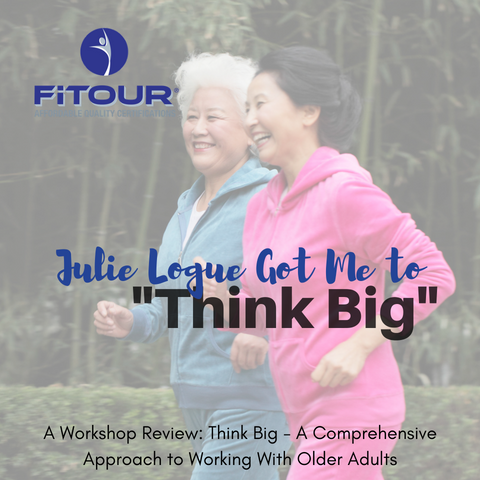Submitted by Melissa Vidito on

At IDEA World in June I participated in a workshop that broadened my perspective on working with the quickly growing older adult population. The presenter, Julie Logue, did not bore us with a self-serving monologue about her career accomplishments to date; instead, Julie began the session immediately with a speed and reaction time training technique she termed, "claptology", and then we got to work. She incorporated movement and interaction throughout the workshop so that by the end I found myself thinking, “Wait...what? It’s already over?” No doubt, Julie will be wowing scores of fitness professionals in the coming years.
The workshop, Think Big--A Comprehensive Approach to Working With Older Adults, offered countless nuggets of useful info for veteran fit pros and newbies alike; it was Julie’s focus on six training principles that I found most beneficial.
According to Julie, for most older adults, “good health ensures independence, security, and productivity as they age. Yet millions struggle with health and safety challenges such as chronic disease, falls, and mental health issues.” She suggested that ALL senior fitness should catalyze improvement by including each of the following six training principles:
-
Activities of Daily Living
-
Safety
-
Functional Movements
-
Skills Training
-
Cognitive Health (the movement complexity)
-
Intensity options
With these principles as the framework of movement selection and class design we are effectively meeting the needs of the older adult population. For instance, there is no reason for an older adult to perform a box jump; steps ups, however, have a place in the older adult fitness class. Let’s look closely at how a standard step up can fit within Julie’s six principles. This simple activity will shed light on how to take a single exercise and determine if it works for your class needs.
Movement: The Standard Alternating Step Up.
-
Activities of Daily Living: Alternating step ups increase cardiovascular endurance and mimic the action of walking a flight of stairs.
-
Safety: The step height can be altered per the class participants ability level with or without the use of risers.
-
Functional movements: The action of walking stairs, stepping up onto a curb, lifting the leg to move from the gas pedal to the brake pedal, putting on pants and socks, and tying shoes are all functional movements that can be made easier by including a standard step up in the class.
-
Skills Training: These include speed, reaction time, balance, agility, coordination and power. The standard alternating step up calls immediately on key stabilizers for balance. Challenges can be added as the class session continues to add skills to the step up. Perhaps a partner ball pass or some intensity options to challenge participants could be incorporated.
-
Cognitive Health: The movement complexity will tap into cognitive health. The standard alternating step up can become a cognitive challenge by changing the step up sequence. For example, it can begin with alternating step ups, transition to right lead only, then left lead, and then create a combination of step ups to challenge the coordination and cognitive ability.
-
Intensity Options: We can increase the intensity by increasing the speed or adding resistance.
While these principles must be considered if you are teaching the active older adult population, the truth is, all movement in an exercise class should have a purpose. After all, according to the U.S. Department of Health & Human Services, more than 80% of adults do not meet the guidelines for both aerobic and muscle-strengthening activities per week.
This staggering percentage of inactive Americans should lead us to understand a small but powerful conclusion: exercise needs to be PURPOSEFUL. If most adults aren’t even exercising, why do we design classes with movements that they wouldn’t even do within their daily activities? Why are we asking our classes and clients to jump onto a 24” box when all they need to do is be able to climb stairs, play catch with their grandkids, and unload the dishes without straining their backs?
I found Julie’s workshop incredibly beneficial as I consider my current aging client roster; but it also shed light on how I design a general population fitness class. It certainly got me to “Think Big” and reconsider my approach across the board.
